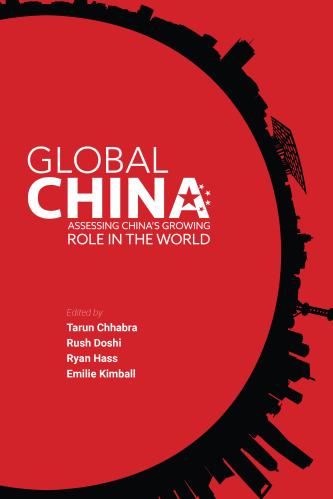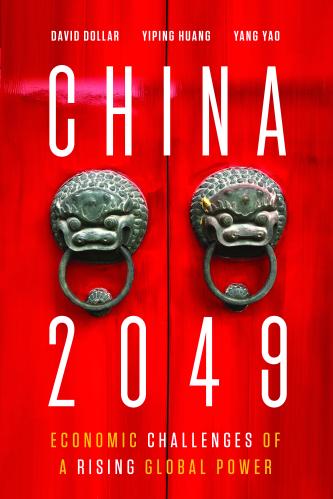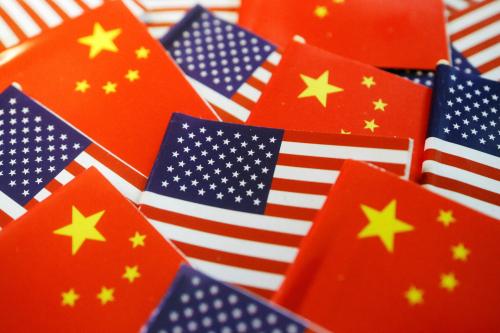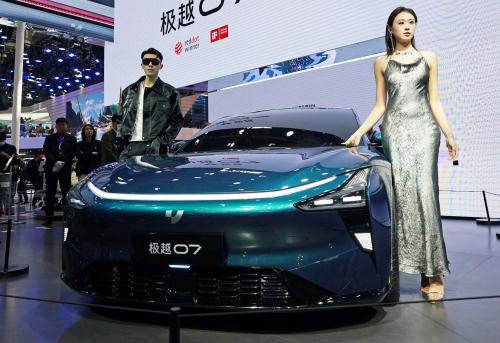The Inflation Reduction Act (IRA) is America’s biggest and most significant national policy geared toward combating climate change. The legislation provides an estimated amount of $300 billion worth of subsidies over the next decade to stimulate a low-carbon transition and to onshore renewable energy manufacturing. While it is a significant achievement to bring renewable energy manufacturing back to American soil, it is unclear whether this goal can be achieved without disrupting the global supply chain in which China is a major player.
The question on the horizon for both Washington and Beijing is whether to leave room for collaboration to facilitate the low-carbon transition or to decouple for the sake of strategic competition. Blind dependence creates energy security risks while overt decoupling slows green technological deployment and endangers the global climate agenda. Having witnessed the disruptive decoupling of the semiconductor industry, it is critical that both countries weigh the costs and benefits before making decisions driven by geopolitical impetus regarding renewable energy manufacturing.
Growing Concern about Energy Security and Its Critique
The concentration of clean tech manufacturing capacity in China has sounded an alarm in Western capitals about energy security. According to Figure 1, China commands a much bigger lead in renewable energy manufacturing capacity than OPEC does in oil, where 13 separate states control roughly 40% of global oil production. China also produces over 50% of lithium and nickel, as well as roughly 70% of cobalt — minerals critical for renewable energy manufacturing — extending China’s lead upstream. Additionally, Russia’s recent weaponization of energy dependence has exacerbated the anxiety among Western leaders over China’s dominance in renewable energy and its potential national security implications.

However, the analogy between dependence on fossil fuels and renewable energy is imperfect at best. Unlike fossil fuels, which depend heavily on the natural endowment of a given country or region, renewable energy can be generated almost anywhere on Earth, significantly decreasing an energy exporter’s leverage. Additionally, fossil fuels are consumables that can be disrupted anytime because of political conflicts. Renewable energy technologies, on the other hand, produce energy constantly once deployed, meaning a U.S.-China conflict today will not stop American solar panels installed yesterday from producing electricity, regardless of where the panels were made.
The Biden administration’s ambition to accelerate America’s low-carbon transformation while minimizing national security threats calls for a delicate balancing act. Responsible policymakers in both countries need to identify specific economic and security risks associated with renewable energy collaboration and develop mitigation plans through consulting with both the public and private sectors. As U.S. Energy Secretary Jennifer Granholm recently said, “We want to be able to have our own energy security here. At the same time, the administration has taken some steps that would allow Chinese companies and Chinese goods to enter the market.” One may argue that while technologies may have a country of origin, the effects of carbon emissions are not confined to a single country. The global renewable energy transformation depends not on who builds more manufacturing capacity, but rather on how fast the planet can reduce its carbon footprint.
Business Initiatives and Political Debate on Clean Energy Cooperation with China
The urgency of deliberation is perhaps best exemplified by the controversy surrounding the partnership between Ford and China’s Contemporary Amperex Technology Co. Limited, or CATL, to build a $3.5 billion battery plant in Michigan. Citing national security concerns and economic interests, both West Virginia Sen. Joe Manchin, a Democrat, and Florida Sen. Marco Rubio, a Republican, have vowed to derail the deal. Despite political headwinds, the Ford-CATL partnership is perhaps only the start of a series of potential collaborations between the United States and China on renewable energy. With geopolitical tensions on the rise between the top two global emitters, balancing renewable energy collaboration and strategic competition carries ramifications not only for bilateral relations but also for the global effort to combat climate change.
The global transition to clean energy is speeding up. Total investment in low-carbon energy transition projects and products topped $1 trillion for the first time in 2022. Although the U.S. renewable energy sector is booming, the country is still not manufacturing enough equipment to meet domestic demand. In 2021, America produced only 5 gigawatts of solar panels, while the industry as a whole installed more than 20 gigawatts worth. To take advantage of the incentives provided in the IRA and to meet the carbon-neutral targets set by the Biden administration, the United States needs to speed up its renewable energy transformation.
America’s low-carbon transformation, as widely noted, will likely be slow and costly if decoupled from Chinese involvement. According to the International Energy Agency, China has traditionally established itself as the front-runner in the global supply chain of green technology. As the CEO of Mitsubishi Heavy Industries Americas said recently, “For America to win its challenge against climate change, you cannot build everything in Japan or America.” Utilizing the scale and know-how of Chinese manufacturers will be key to ramping up domestic supply in an industry in which the United States is playing catch-up in the global market. However, powerful political opposition has formed on both sides amid rising geopolitical tensions.
Besides the aforementioned energy security concerns, rising technological nationalism in an age of great power competition is another hurdle that any bilateral collaboration needs to overcome. American policymakers are increasingly alarmed about Chinese companies benefiting from the IRA subsidies by manufacturing in the United States, arguing that American tax dollars should not reward America’s foremost geopolitical challenger. However, restrictive trade policies will not help the United States outcompete China in renewable energy, which has thrived under anti-dumping and countervailing duties from the U.S. federal government for the past decade.
On the contrary, to better compete, the United States needs to take a page from the playbook of Asian economies such as China, Japan, and South Korea, which all evolved from technological latecomers to exporting powerhouses. Encouraging foreign companies to set up assembly lines domestically, independent from geopolitical or ideological calculations, eventually helped those countries move up the value chain by cultivating vibrant and competitive domestic supply chain clusters. Hence, the success of the IRA should not be judged solely on whether Chinese companies will benefit, but rather on whether new investment can make America more competitive in renewable energy by cultivating local supply chain clusters regardless of the origin of such investment.
While American policymakers have been alarmed by China’s involvement in the domestic renewable energy supply chain, their Chinese counterparts have also expressed reservations. The Ford-CATL partnership is also said to be under scrutiny from the Chinese government, which is tightening its control over cross-border investment in fields where China holds a technological advantage. China’s Ministry of Commerce has included advanced photovoltaic silicon wafer technologies in a draft list of technologies restricted for export. It is tempting for China to leverage its dominance in renewables as a stranglehold for strategic competition with the United States, especially after having been denied access to advanced semiconductor technologies by Washington and its allies. However, doing so could be counterproductive to the global expansion of the Chinese renewable energy industry and jeopardize global efforts combating climate change.
Climate Agenda and Global Public Goods
Global efforts to combat climate change are at a critical juncture. Preventing U.S.-China clean tech collaboration from turning into the “next semiconductor” is vital for the fate of a planet facing increasing climate challenges. Properly handled, U.S.-China collaboration in clean tech could further drive carbon reduction of the top two emitters, build trust, and put a floor under the deteriorating bilateral relationship. If framed as yet another battleground for zero-sum competition, however, mutual hostility in the form of trade restrictions and technology decoupling will disrupt global supply chains and torpedo the climate agenda worldwide.
From a bilateral perspective, U.S.-China collaboration on renewable energy will create positive momentum for trade negotiations. By holding companies accountable regardless of their country of origin, the U.S. government will set an example of regulated collaboration in a rules-based international system and demonstrate its sincerity in responsible competition. At the same time, the practice of licensing Chinese renewable energy technologies incentivizes the Chinese government to value intellectual property rights. Creating a level playing field for foreign companies during a period of high geopolitical tension and enforcing commercial intellectual property protection will give America leverage to demand reciprocity from the Chinese side during trade negotiations. After all, American investment and business interests in China are significantly greater than those of China in the United States.
Without strategic foresight, renewable energy technologies can easily become the next victim of great power competition following semiconductors. Instead, renewable energy products should be recognized as public goods that all responsible countries should provide, unlike technologies such as semiconductors. A low-carbon, sustainable future is not a prize of geopolitical competition. While geopolitical competition can last for decades, climate action is needed now. Decisionmakers in both countries need to be strategic and bold to set the boundaries of competition and leave room for collaboration to avoid harmful competition that will doom the future of our planet.
The Brookings Institution is committed to quality, independence, and impact.
We are supported by a diverse array of funders. In line with our values and policies, each Brookings publication represents the sole views of its author(s).









Commentary
Renewable energy should not be the next semiconductor in US-China competition
June 14, 2023